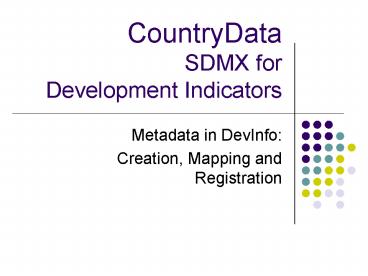CountryData SDMX for Development Indicators - PowerPoint PPT Presentation
Title:
CountryData SDMX for Development Indicators
Description:
CountryData SDMX for Development Indicators Metadata in DevInfo: Creation, Mapping and Registration Final Step: Select mappings Final Step: Generate SDMX-ML Final ... – PowerPoint PPT presentation
Number of Views:71
Avg rating:3.0/5.0
Title: CountryData SDMX for Development Indicators
1
CountryDataSDMX forDevelopment Indicators
- Metadata in DevInfo
- Creation, Mapping and Registration
2
Metadata
- According to the ISO
- Metadata is data that defines and describes
other data. - Perhaps, better visualized as layers within a
pyramid. - Information describing the data is more detailed
as one moves down from the top of the pyramid.
3
Structural metadata
- At the top of the pyramid is information
essential for understanding the data - Needs to explain the basics of when, where, who
and what?
4
Reference metadata
2. In the middle are explanatory notes and text
generally located in the same publication
provides a good description of the statistics
- definitions, key issues, limitations, etc., that
can impact on the use of the data.
5
Methodological metadata
- 3. Detailed methodological information
disseminated in publications / websites. - These are potentially the source of the most
detailed methodological information available. - Some statistical agencies publish very detailed
concepts, sources and methods for a number of
their key statistics.
6
CountryData Metadata Structure Definition (MSD)
background
- Developed by UNSD for CountryData
- Supports exchange of CountryData Indicator
metadata between countries and UNSD - Implemented in SDMX 2.0
- Design to exchange higher level reference
metadata - Latest version (1.0) finalised in Dec 2012
7
DevInfo (Di) background
- Data and metadata dissemination software
supported and promoted by UNICEF - DevInfo7 (Di7) launched in Nov 2012
- 7 out of 11 project countries plan to share
metadata through DevInfo - Good support for metadata collation and exchange.
8
Mapping to the MSD
- Metadata mapping from DevInfo to MSD is much
simpler than data mapping. - MSD structure is simpler and no part is
mandatory. - Expectation that at least Definition, Method
of Computation and Process of obtaining data
are available.
9
Open metadata in admin tool
10
Set metadata structure
11
Edit metadata by indicator
12
Export list to excel
13
Export all or selection
14
Create/ choose excel file
15
Open excel file and edit
16
Import file into di database
17
Select excel file used to edit
18
Import excel file used to edit
19
New metadata imported
20
Di Mapping Tool Introduction
- Once the metadata is entered into the database,
then can use DX Remote Access to update di7
web-based software in same way as data - Once metadata exists in di7 web then metadata can
be mapped and published which conforms with the
CountryData MSD. - Like for data, this is all done online through
the di7 web-based repository through the
administration profile, so lets begin
21
Getting Started
22
Scroll down to Registry menu
23
Log onto administrative profile
24
Prepare the Dbase for mapping
25
Prepares the SDMX artifacts
26
If DSD in place, ready to map
27
Metadata mapping
- To map metadata,
- First, map the associated time series through
(1st stage) codelist and (2nd stage) IUS - Once this is complete move to mapping metadata
28
Metadata mapping
29
Metadata mapping
30
MSD Concepts
31
Map Metadata concepts
32
Confirm mapping saved
33
Final Step Register the mappings
34
Final Step Select mappings
35
Final Step Generate SDMX-ML
36
Final Step Complete
37
Exercise Publish metadata
- Use unstats.un.org/unsd/demodiweb1-6
- Username webmaster_at_xyz.com
- Password support_at_2012
- Publish/ register the time series for
- Maternal mortality ratio (MMR)
- Employment to population ratio
- Share of women in wage employment in the
non-agricultural sector - Infant mortality rate
- Land under forest cover
38
MSD Maintenance
- The mapping and registry tool allows users to
edit and delete the MSD (has to be packaged with
the DSD and uploaded in DevInfo). - For when the MSD is updated, it is recommended
to edit the DSD/MSD rather than delete - MSD/DSD deletion has the effect of removing all
the mappings and subscriptions used for that
MSD/DSD
39
MSD Maintenance
40
MSD Header































